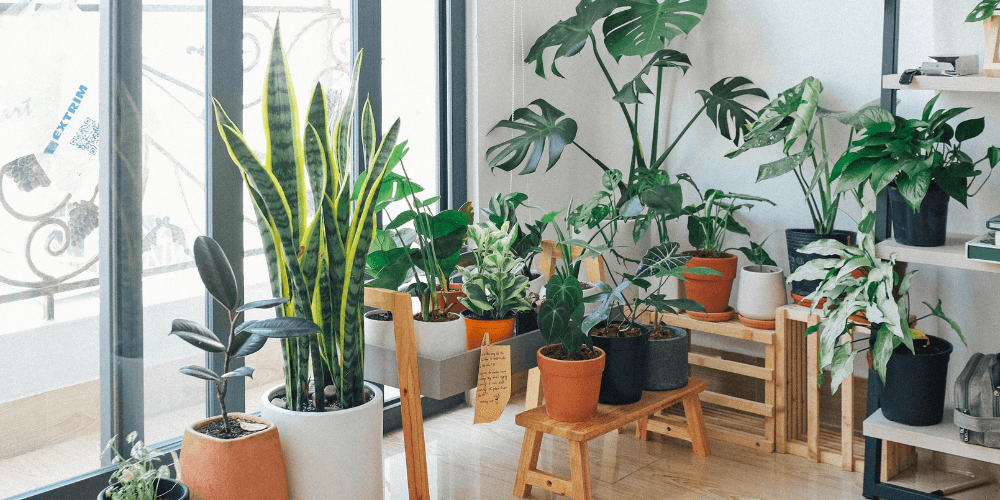The connection between humans and the natural world can sometimes feel tenuous in today\’s urbanized world. However, indoor gardens offer a solution, bringing a touch of the outdoors right into our homes. From flourishing herb gardens to edible vegetables and vibrant flowers, indoor gardens add life, colour, and a sense of serenity to any space.
What is an Indoor Garden?
An indoor garden is the practice of growing plants indoors rather than in a traditional outdoor garden setting. Indoor gardens can range significantly in size and complexity. Some may be simple potted plants, while others may be elaborate hydroponic systems. While sunlight is still important, indoor gardeners often supplement this with artificial grow lights.
Real-World Benefits of Indoor Gardening
Indoor gardens offer advantages beyond just their aesthetic appeal. Here are some real-world cases showcasing their benefits:
- Improved Air Quality: Plants are natural air purifiers. NASA studies demonstrate how common houseplants significantly remove pollutants and toxins from the air, boosting indoor air quality.
- Enhanced Mental Health: Indoor gardening is associated with reduced stress, anxiety, and depression. The act of nurturing plants offers a calming and therapeutic process.
- Fresh and Healthy Food: Many indoor gardens focus on herbs, vegetables, and even fruits, providing a year-round supply of fresh, pesticide-free produce.
- Educational Value: Indoor gardens serve as interactive learning tools for people of all ages, promoting an understanding of plant life and the importance of a sustainable food system.
- Sense of Community: Indoor gardens can foster a sense of community for urban dwellers in apartments or areas with limited green space through shared plant knowledge and exchanges.
The Essential Pros and Cons of Indoor Gardens
Like any gardening technique, indoor gardening comes with its own set of potential drawbacks and advantages :
Pros
- Year-round Gardening: Enjoy gardening regardless of the weather or season.
- Pest and Disease Control: Indoor plants are less susceptible to common outdoor garden pests and diseases.
- Space Efficient: Indoor gardens are a great way to maximize growing potential in limited spaces.
- Enhanced Aesthetics: Add visual interest and vibrancy to any room in your home.
Cons
- Cost: Indoor gardens may require an initial investment in equipment, such as grow lights and containers.
- Time Commitment: Plants still need regular care and maintenance.
- Limited Plant Options: Not all plants are suitable for indoor growth due to size or light requirements.
- Humidity and Ventilation: Depending on plant choices, humidity management can be important to prevent mould and fungal growth.
Tips and Ideas for an Indoor Garden
Getting started with your own indoor garden is easier than you might think! Here are some tips and ideas to get you growing:
- Choose the Right Plants: Consider the light conditions in your home and select plants that thrive in those conditions. Easy-to-care-for plants like pothos, snake plants, or herbs are excellent choices for beginners.
- Location Matters: Place your indoor garden in a spot that receives adequate light. This could be a sunny windowsill, or you may need artificial light.
- Proper Watering: Overwatering is a common problem. Research your plants\’ water needs, and allow the soil to dry out between waterings partially.
- Fertilize: Use a liquid fertilizer designed for houseplants to give them the necessary nutrients.
- Experiment and Get Creative: Indoor gardens offer endless possibilities. Try window boxes, vertical hanging planters, terrariums, or even advanced hydroponic systems.
Tips and Ideas for a Flourishing Indoor Garden
- Think Vertical: Optimize space with vertical gardens. Options include hanging baskets, wall-mounted planters, tiered shelves, or even DIY trellis systems for climbing vines.
- Repurpose and Upcycle: Get creative with containers. Old mason jars, teacups, vintage tins or even repurposed drawers make unique and stylish planters.
- Play With Textures: Don\’t just focus on flowers. Incorporate plants with varying leaf shapes, textures, and colours for visual interest. A mix of smooth and ruffled leaves or variegated foliage adds depth to your indoor garden.
- Group Plants with Similar Needs: Plants should be placed together with similar water and light requirements. This simplifies care and creates a balanced aesthetic.
- Edible Gardens: Grow a culinary haven! Compact varieties of tomatoes, peppers, salad greens, and herbs flourish indoors with proper light. Consider microgreens for a super-fast and nutritious harvest.
- Themed Gardens: Get inspired! Design a succulent garden for a low-maintenance option, a Zen garden with ferns and moss, or a colourful tropical paradise with vibrant bromeliads.
- Self-Watering Systems: Busy schedule? Explore self-watering planters or wicking systems to reduce the frequency of manual watering.
- Propagation Station: Make your indoor garden self-sustaining. Include a dedicated area for propagating cuttings or starting seeds, expanding your plant collection at a minimal cost.
- Beneficial Companions: Mimic nature\’s wisdom by strategically planting companions. Intersperse marigolds to deter pests or plant basil beneath your tomatoes for flavor enhancement.
- Decorative Touches: Integrate your indoor garden seamlessly with your decor. Add pebbles, figurines, or miniature fairy garden elements for a whimsical touch.
Additional Considerations
- Humidity: Many tropical plants thrive in humid environments. Utilize a mister or a pebble tray, or consider a small humidifier for your humidity-loving plants.
- Air Circulation: Good air circulation helps avert diseases. A small fan gently circulating air near your plants can make a difference.
Conclusion
Indoor gardens are a fantastic way to transform your living space into a vibrant and healthy oasis. Bringing the beauty and benefits of nature inside can improve your air quality, mental well-being, and overall quality of life. Whether you\’re a gardening enthusiast or simply seeking a touch of greenery for your home, embrace the versatility of indoor gardening.
Disclaimer
The information provided in this blog is for general informational purposes only. Always consult a gardening expert or relevant resource for specific plant selection and care guidance.


